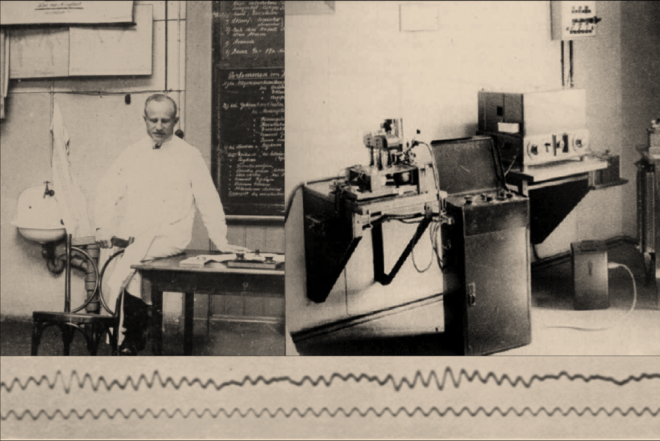How a dead frog and a telegram led to the discovery of the human encephalogram.
If scientific progress is a series of building blocks, then frankenfrog began it all. The year was 1780 and Luigi Galvani had a theory. He connected a generator of static electricity to the legs of a recently dead frog, showing that it would twitch when an electric current was applied either to the nerve or to the muscle. In a series of experiments he carefully proved that the electricity was innate to the animal tissue. He called it animal electricity.
Fast forward to 1892. A German military grunt receives a telegram from his father, asking after his health. The timing sends ripples down his spine. Just that morning he had fallen in front of a horse-drawn cannon and nearly died. The young man learns that his sister had been overcome by an ominous feeling that morning and insisted that his father send the telegram. He reasons that somehow, in his intense terror, he must have sent her a psychic message.
The young man was Hans Berger and this single experience changed the course of history. Berger became fascinated with the physical manifestations of psychic energy and decided to devote his life to studying the relationship between mind and matter. He earned a degree in medicine, began a long and successful career at the University of Jena and ultimately revolutionized the field of neuroscience with his invention of the human electroencephalogram (EEG).
Berger’s work was done in solitude, but not in a vacuum. He was first and foremost a scholar. He poured over years of relevant research, analyzing and incorporating ideas from various fields of science.
Alfred Lehmann’s work was of particular interest. Lehmann applied conservation of energy principles to the brain. He believed that the brain released heat, electricity and p-energy (psychic energy). According to Lehmann, this p-energy was associated with the human soul. The framework revealed, at least theoretically, a method of identifying and measuring physical manifestations of the mind.
Berger’s ultimate goal was not to measure electrical currents from the human brain. The development of his EEG was no more than a stepping stone, a means of approaching a more controversial science. Berger was trying to uncover the scientific basis of telepathy.
Using Lehmann’s framework, Berger began systematically tackling the pieces of this puzzle. When his work in brain blood-flow failed to provide answers to his questions, he moved onto thermodynamics and then, finally, electricity. Towards this aim, he studied the work of Richard Caton, who had used a galvanometer to amplify and read the electric waves in several animal brains. His findings had been reported to the British Medical Association in 1875. Whether these same waves existed in humans remained to be discovered.
Berger was determined to find and measure this energy, but he had a lot of work to do. The instruments at his disposal were primitive and difficult to work with. Experts in the field believed it couldn’t be done. Berger didn’t even have a background in electrics. When the American roboticist William Grey Walker visited Berger’s lab, he took a liking to the man, but wrote in The Living Brain that “he had one fatal weakness: he was completely ignorant of the technical and physical basis of his method. He knew nothing about mechanics or electricity.”
The power of dedication should never be underestimated. Against all odds, Berger succeeded. The first EEG recordings were made in 1924, using clay electrodes attached to a patient’s skull and a small galvanometer. He waited 5 years to publish his results. By then he had improved his technique and updated his tools. The recordings that had been no more than shadows of evidence in 1924, were now distinct wave patterns.
At first Berger’s findings landed on deaf ears. He was an isolated and solitary man. He never spoke of his research into the electricity of the brain, and no one asked. Dr. Raphael Ginzberg, who worked with Berger for several years, noted his antisocial behavior and further commented that he was “credited with little scientific or psychiatric insight.” He was considered an uninteresting, unimaginative amateur by his peers.
It wasn’t until a more decorated neurophysiologist tried to invalidate Berger’s work and ended up replicating it that the EEG became a celebrated scientific development throughout Europe. The same celebration never reached Berger’s homeland, and EEG research was eventually banned by the Nazi regime. Berger was never able to complete his inquiry into the physical manifestations of the mind. Amidst increasingly severe health problem and general depression, he committed suicide in 1941.
Since then the EEG has become a cornerstone of modern neuroscience and put to use in the areas of brain tumors, epilepsy and sleep. Yet we are still just at the very beginning of our understanding of this signal and harnessing it’s potential. Its renaissance is just beginning and it all started with a dead frog, a telegram and one man’s dedication to explaining the human mind.
Erin Wildermuth is an aspiring MD/PhD student and is presently working in a neuroscience lab studying memory.

















Do not forget Adolf Beck and Richard Caton who has first recorded electrical activity from the animals brain:
https://en.wikipedia.org/wiki/Adolf_Beck_(physiologist)
https://www.ncbi.nlm.nih.gov/pubmed/22101137
http://neuronusforum.pl/2013/becks-memorial.pdf
https://en.wikipedia.org/wiki/Richard_Caton
https://www.ncbi.nlm.nih.gov/pubmed/16435031
https://www.ncbi.nlm.nih.gov/pmc/articles/PMC3902832/